nano@Illinois RET Teachers Experience Cutting-Edge Nanotechnology Research—Introduce It to Their Students
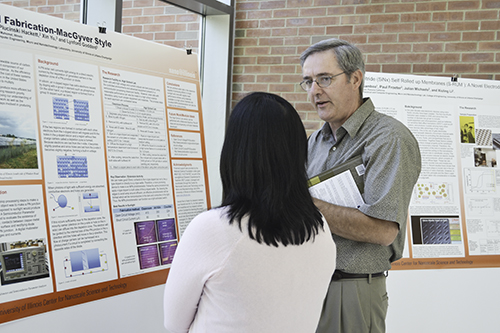
nano@illinois RET Master Teacher Terry Koker explains his research to a visitor to the poster session.
September 18, 2017
In its fourth and final year, the nano@illinois Research Experience for Teachers (RET), funded by the National Science Foundation, offered eleven P–20 STEM teachers the opportunity to do cutting-edge research in nanotechnology under some of Illinois’ premier researchers in the field. The second emphasis of the RET was for teachers to develop modules related to their research that could be used in their own and other classrooms. The goal of the RET is that, based on teachers’ resulting enthusiasm, content knowledge, and increased familiarity with possible careers in the field, along with the modules they develop, which will be available for use by other teachers as well, a larger number of students will be exposed to the field.
Near the end of the six-week research program, the teachers presented their research at a research symposium/poster session held at MNTL on August 8th. In addition to University folk, a group of Urbana High School students participating in I-STEM’s summer camp attended their research presentations to discover what a research presentation is like and to get pointers for making their own poster presentations down the road.
While the short-term goal of the RET was to expose the RET teachers to research, the hoped-for long-term impact was to expose students, especially underserved populations, to nanotechnology research, specifically, and to STEM in general through lesson modules. The teachers began developing these this past summer and will complete them over the course of the next year in order to use with their students in their own classrooms. One challenge many encountered when coming up with the idea for their module was that they had been doing research in a cutting-edge lab using expensive equipment; however, their goal was to develop lesson plans that replicated something similar to their research but that any teacher could implement in his or her classroom using inexpensive, easily accessible materials/equipment.
Excited about the experience, teachers not only felt they had learned a wealth of new information about the subject area they had researched, but that they had grown personally and as teachers, and felt confident about sharing their new knowledge and skills with their students.
Antonio Gamboa
For example, Antonio Gamboa, who teaches Chemistry, Biology, and AP classes in Pomona, CA and was in his second year in the RET, couldn’t wait to share all that he had learned with his students. “It actually was fantastic,” Gamboa reports, “because it really confirmed all that I learned last year, and I was able to even improve on everything. And what I bring to the high schools is gonna’ be fantastic…I feel really confident now to actually implement what I learned,” he says.
While he also worked with cells and neurons during his research this summer, one significant accomplishment that relates to his high school students was the creation of a solar panel. “So the students will be able to create a solar panel in the classroom,” he says, “and it’s really fast, easy, inexpensive; the lesson is all written and available for teachers; so it's really exciting.
Having participated in research for two summers now, Gamboa calls research, “It's essential. I mean high school students—anybody should participate. I think they should be exposed to the fact of being able to try to find out something new. Just to learn something you didn't know and to question, I think is fantastic. That's a great opportunity.”
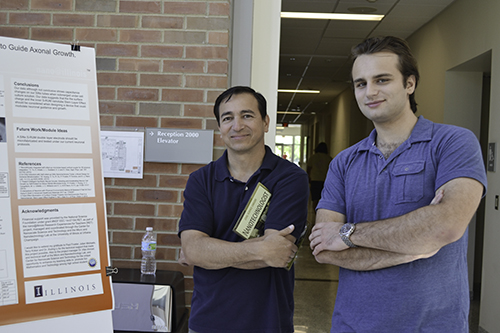
Antonio Gamboa (left) poses with his Ph.D student mentor in front of his poster.
Gamboa shares what he gained personally from participating in the RET. Along with a lot of new knowledge, he says, “I have confidence on new information and futuristic views. I think, at least for myself, it totally transforms my classes— the way that I can teach it, the way that I approach it. Instead of being the old style of teaching, this gives you a total refreshed view, and totally different way to see it and present it and the interactions with the teachers too were phenomenal.”
Regarding the positive impact participating in the I-STEM camp and attending their poster presentation had on the local high schoolers, Gamboa shares why it was good for the students to come to something like this:
“It opens up their eyes,” he says. “It's very difficult in high school to be able to see the opportunities. You can tell them, talk to them, show them, but there's nothing like walking on a campus, seeing the buildings, talking to people, seeing the posters, seeing everything. It all becomes real."
And according to Gamboa, after students participate in programs like this, there's a noticable change. "You notice it when they come back, they are different. What I notice is that they come back and they're ready to go to college. They're excited, motivated, and now they see that it's real. So many of the communities don't have this exposure. They don't have doctors or lawyers; they don't have anybody. You tell them and it seems to be open in the air, like maybe it's for someone else. But once they come, they realize that, ‘Maybe, this is something for me!’ And that is life changing.”
Joanna Simeca
In her first year in the RET was Joanna Simeca, who teaches grades 10, 11, and 12 chemistry at Georgetown Preparatory School in North Bethesda, Maryland (just outside of Washington D.C.)
Simeca joined the RET to get experience doing research in the physical sciences. Because her background is in biology life sciences, she says she has lots of research experience there. “But I've never worked in an engineering facility or with any type of chemistry or physics research,” she says, “so it was really cool to actually get some experience there, and hands-on research that was not biology based. I was looking for a summer job too, so it was a fun way to learn more about science and also do something with my summer.”
Simeca’s research involved finding the best way to make one-atom-thick layers of materials. They used a semi-conductor, molybdenum disulfide. “It's really customizable,” she reports, “more customizable than graphene, so scientists are really interested in it.”
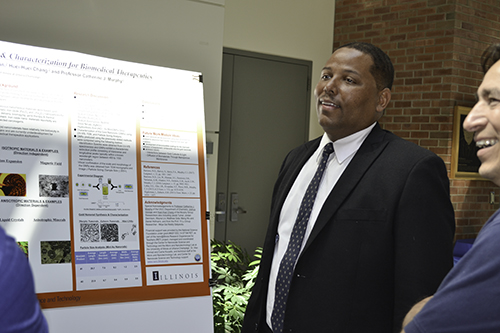
A nano@illinois teacher discusses his research
Is graphene, the wonder child in terms of one-atom-thick materials, getting pushed out of the way? Simeca says no, but that there's a huge body of research about graphene. TMDs (transition metal dichalcogenides), however, are still a relatively new field.
Simeca’s main takeaway from the summer was that she “learned a lot about the engineering process and how engineers have to keep trying and refining their process to find their best way to do something, rather than discovering never-before-seen scientific principles, which is what I would understand scientists do. So I got exposed to what engineers do”
She reports that it “was really cool to see how they keep tweaking their processes to learn.” Although she learned a lot about basic nanotechnology lab techniques, she won’t be able to use them in her class because her school doesn’t have any of the equipment, “But I learned a lot of what can be done,” she admits, “a lot about the field of nanotechnology, and what areas of our society are impacted by it.”
She’s not sure yet what project she’s going to take back to her students. She indicates that she might do some experiments that involve breaking water down into hydrogen and oxygen gas and finding the best way to do that most efficiently with a battery, “which is kind of an application of what I was doing,” she says. She might also investigate how polymers can be applied to glass to make anti-reflective coatings like on glasses. “So that would teach my students about polymer chemistry and some inter-molecular forces.”
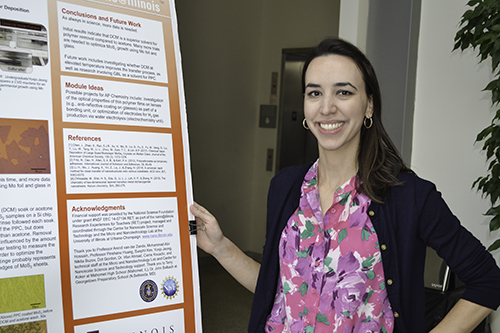
nano@illinois teacher, Joanna Simeca and her poster
If a student were to come to her considering a career in research, Simeca says she would tell him or her to first, go to a research university that has programs that they’re interested in, but has a wide variety of programs. “So that if you get there and you decide you don't like material science, you can also still study electrical engineering or whatever,” she says.
She would also encourage the student to get undergraduate research experience early on “Reach out to professors; be persistent; get some undergraduate experience as soon as you can. If you don't like the first lab you're in, keep trying. I worked in three different labs as an undergrad, and even this was the best experience I've had in a lab. Keep trying, even if it doesn't click at first, keep trying."
She would also encourage students to do some kind of summer program at the high school level, like maybe the ones that the University of Illinois offers, or more local ones, that could be a good way to expose them to those programs too.
J. D. Graham
A local teacher, J. D. Graham, teaches biological sciences to grades 9–12 at Sullivan High School in Sullivan, Illinois.
Graham’s research involved using a nanoSIMS machine to separate out atoms or ions according to their mass by sputtering (hitting a cell and exploding an area over and over), thus removing layer by layer, nano-meter by nano-meter, to create a 3D model of where all of those atoms were, then label them and associate them with certain organelles, enabling researchers to learn their composition and their position, which has never been done before at this resolution.
The lesson that Graham is going to have his students do is in two parts. The first involves using cigarette smoke extract to make exosomes, which are associated with both cancer communication and with bio-replication. In his lab, they would chemically induce a virus to replicate using cigarette smoke extract. “Do those exosomes look the same?” Graham says. “And if they do, can we disrupt or control their formation, thereby stopping viruses from replicating or stopping cancer cells from communicating?
The second part involves working with a colleague at another school district who’s going to have his students making silver and gold nano-particles. Students will be doing a cytotoxicity test to see how much cigarette smoke extract, nano-gold (almost completely non-toxic), and nano-silver (which has some toxicity) it takes to kill a certain amount of bacteria.
Regarding what he personally took away from the research experience, Graham indicates that as a teacher, he doesn’t often get to do something like this with people “who are incredibly knowledgeable and passionate.” He reports that he and his fellow teachers, in their role of spurring students on to greater achievement, are “usually pulling very hard up, and here we had people pulling us up, and it's a nice thing.”
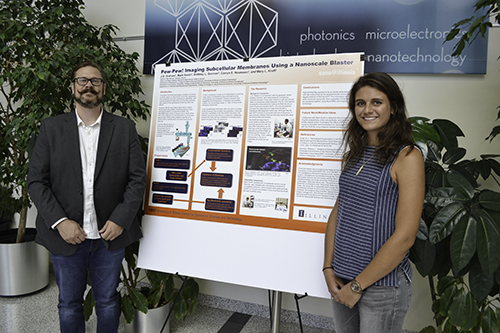
J. D. Graham poses with his Ph.D student mentor in front of his poster
He adds that the biggest impact was related to depth of learning. He would reach a point where he thought he understood what they were doing, “but then, every day, come back to find out that I don't understand it as well as I thought, and to find out that there's another layer of understanding, another layer of ideas. Every day I came in, I thought I had a handle on it; every day, they would then say, one more layer. That's an incredible feeling to have, to just keep going down deeper and deeper.”
Should a student come to him and say, "Hey, I'm thinking about research as a career," Graham says he would tell them, “It's an incredible opportunity. There's always going to be a need for people who can think and can solve problems.”
He’s also hopeful that since he’s been in the RET program and made some connections, he might be able to pull some strings, or at least “definitely find more programs for them to get started and get established.”
He admits that he himself was reluctant to go to grad school after he got his Bachelor's. “A lot of it was just ignorance. I didn't really know what that lifestyle would be like.” But now he knows exactly what grad school is like, “And when you know what something is, when it's familiar, it's much easier to take that next step, and I hope to give a student the ability to become familiar with it.”
The nano@illinois RET is led and administrated by:
- PI Xiuling Li, Electrical and Computer Engineering
- Co-PI Lynford Goddard, Electrical and Computer Engineering
- Irfan Ahmad, Executive Director, Center for Nanoscale Science and Technology, and nano@illinois RET Program Manager
nano@illinois RET is managed by the University of Illinois Center for Nanoscale Science and Technology at the Micro and Nanotechnology Lab.
Author/Photographer: Elizabeth Innes, Communications Specialist, I-STEM Education Initiative
More: MNTL, Nano@illinois, RET, Summer Research, Teacher Professional Development, 2017
For additional istem articles on the Nano@illinois RET, please see:
- nano@illinois RET Participant Tatiana Stine Hopes to Help Expose Youngsters to Nanotechnology
- RET Teachers Experience Multidisciplinary Nanotechnology Research via nano@illinois
- 2015 nano@illinois RET Teachers Perform Nanotechnology Research, Make Modules
- Local Science Teachers Experience Research in NanoTechnology
- Local Biology Teacher to Introduce her Students to Research on Quantum Dots
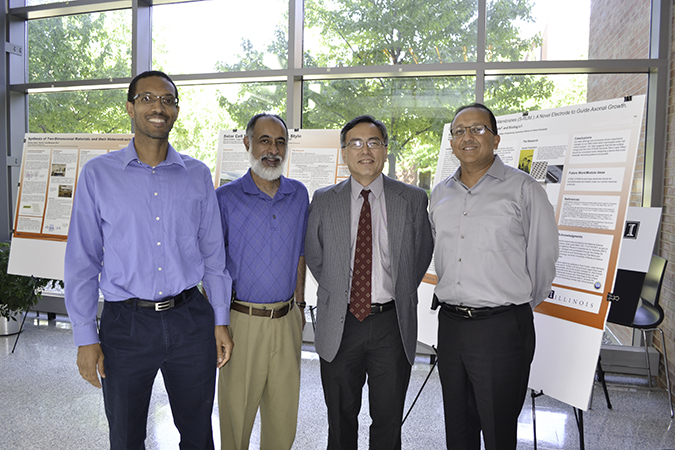
From left to right: Co-PI Lynford Goddard, Electrical and Computer Engineering; Irfan Ahmad, the Executive Director of the Center for Nanoscale Science and Technology and nano@illinois RET Program Manager; PI Xiuling Li, Electrical and Computer Engineering; Rashid Bashir, Head of the Department of Bioengineering













.jpg)
















